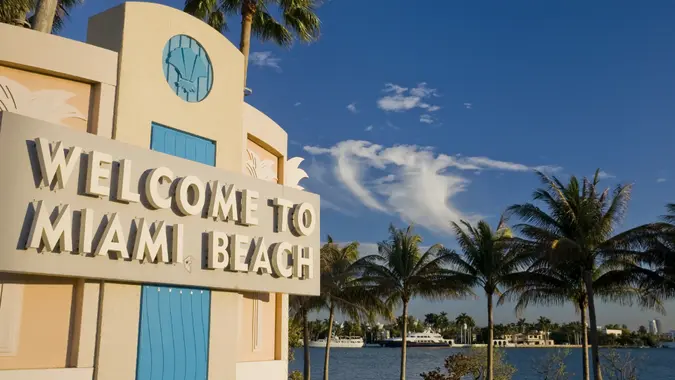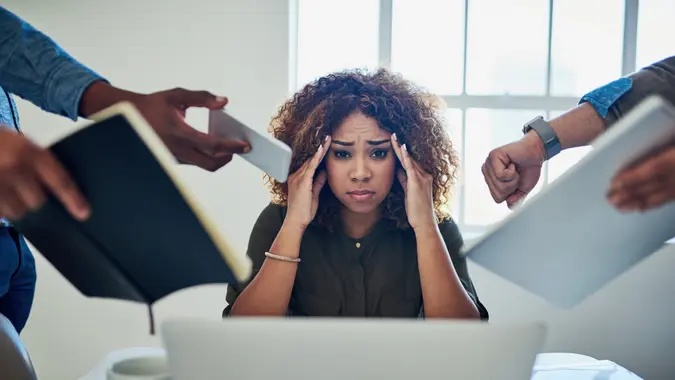6 Rare Coins From the 1800s Worth Thousands That Are Highly Coveted by Coin Collectors

Commitment to Our Readers
GOBankingRates' editorial team is committed to bringing you unbiased reviews and information. We use data-driven methodologies to evaluate financial products and services - our reviews and ratings are not influenced by advertisers. You can read more about our editorial guidelines and our products and services review methodology.

20 Years
Helping You Live Richer

Reviewed
by Experts

Trusted by
Millions of Readers
Not every old coin is worth something, but many from the 1800s sure are. Some coins from this period are worth thousands or tens of thousands of dollars — perhaps even more.
A lot of this value comes from the low mintage. Limited supply often means higher demand, after all. But you’d be surprised at just how much a numismatist (someone who collects old coins) will pay for something they perceive as being truly valuable.
Whether you’re recently inherited a collection of old coins or you just so happened to find one from the 1800s in your couch cushion (lucky), here are some of the most valuable coins from that period and what they could be worth.
1822 American Half Eagle (PCGS) AU-50
- Approximate number minted: 17,796 (regular strike)
Although nearly 18,000 were minted, the 1822 American Half Eagle AU-50 regular strike is one of the rarest coins today. In fact, only three known coins still exist — two of which are part of the Smithsonian Institution collection. This gold coin consists of 8.3% copper and was last purchased by Mr. Eliasberg in 1945 (from Abe Kosoff) for $14,000.
1878 S Trade Dollar PCGS MS68
- Approximate number minted: 4,162,000 (San Francisco Mint)
Despite the large number produced, all grades of the 1878-S Mint State are held in high regard by coin collectors today. It’s widely believed that these coins were largely melted down in the 1950s, but there aren’t any records to verify this.
Regardless, these silver coins are valuable today. One coin sold at an auction back in 2019 for $252,000.
1861 Paquet Liberty Head Double Eagle MS-67 (PCGS) CAC
- Approximate number minted: 2,976,453
Another gold coin, very few of the 1861 Paquet Liberty Double Eagle MS-67 CAC coins remain today. The most common one — until roughly a dozen were recovered from the S.S. Central America wreck — was the Type One issue.
Even now, if you have one of these in your possession, it could be worth a good deal. In 2013, one sold for $352,500.
1838 $10 Liberty Head Gold Eagle PCGS MS-63
- Approximate number minted: 7,200
The 1838 $10 (regular strike) Liberty Head Gold Eagle is considered another rather valuable coin. In 2007, one sold for $115,000. It’s 90% gold, 10% copper.
1880 $4 Coiled Hair Stella PCGS PR67 CAMEO
- Approximate number minted: 10
Not only is this coin old, but it’s exceedingly rare with an estimated 10 ever minted. They’re 86% gold, 10% copper and 4% silver.
At an auction in 2015, one of these coins sold for $1.8 million.
There are a couple of other Stella coins out there, including the 1879 Coiled Hair Stella. But the 1880 version is the rarest of them all.
1804 Draped Bust Dollar PCGS PR68 Class 1
- Approximate number minted: 8
Even rarer than the Stella above is this 1804 Draped Bust Silver Dollar. According to the U.S. Mint, nearly 20,000 silver dollars were minted that year. Many coin enthusiasts, however, believe this number specifically refers to leftover coins from the year before.
Three classes of the 1804 silver dollar exist, but the 1804 Draped Bust Dollar PCGS PR68 Class 1 is perhaps the most valuable. It’s 90% silver, 10% copper. It sold at auction in 2021 for $7.6 million.
How To Identify Rare Coins
Again, not every old coin — even if it is from the 1800s — is considered rare or even valuable. If you happen upon a coin and want to know its worth, here are a few things you can do:
- Take it to a local coin dealer who can examine it closely for any defects or notable marks (such as those along the rim).
- Look for any errors on the mintmark or date (like a re-punched mark or double text).
- Check the lettering carefully for anything unusual, such as doubled-up letters or missing letters. Check both sides.
- Examine the die rotation (angle in which a coin turns). If the rotation seems odd, it could be indicative of a rare or valuable coin.
If you have a valuable coin from the 1800s — or any other era — and have gotten it properly appraised, you can keep it or sell it. For the latter, you may want to consider putting it up for auction on a platform like Stack’s Bowers, David Lawrence Rare and Certified Coins (DLRC) or USA Coin Book.
 Written by
Written by  Edited by
Edited by 

























